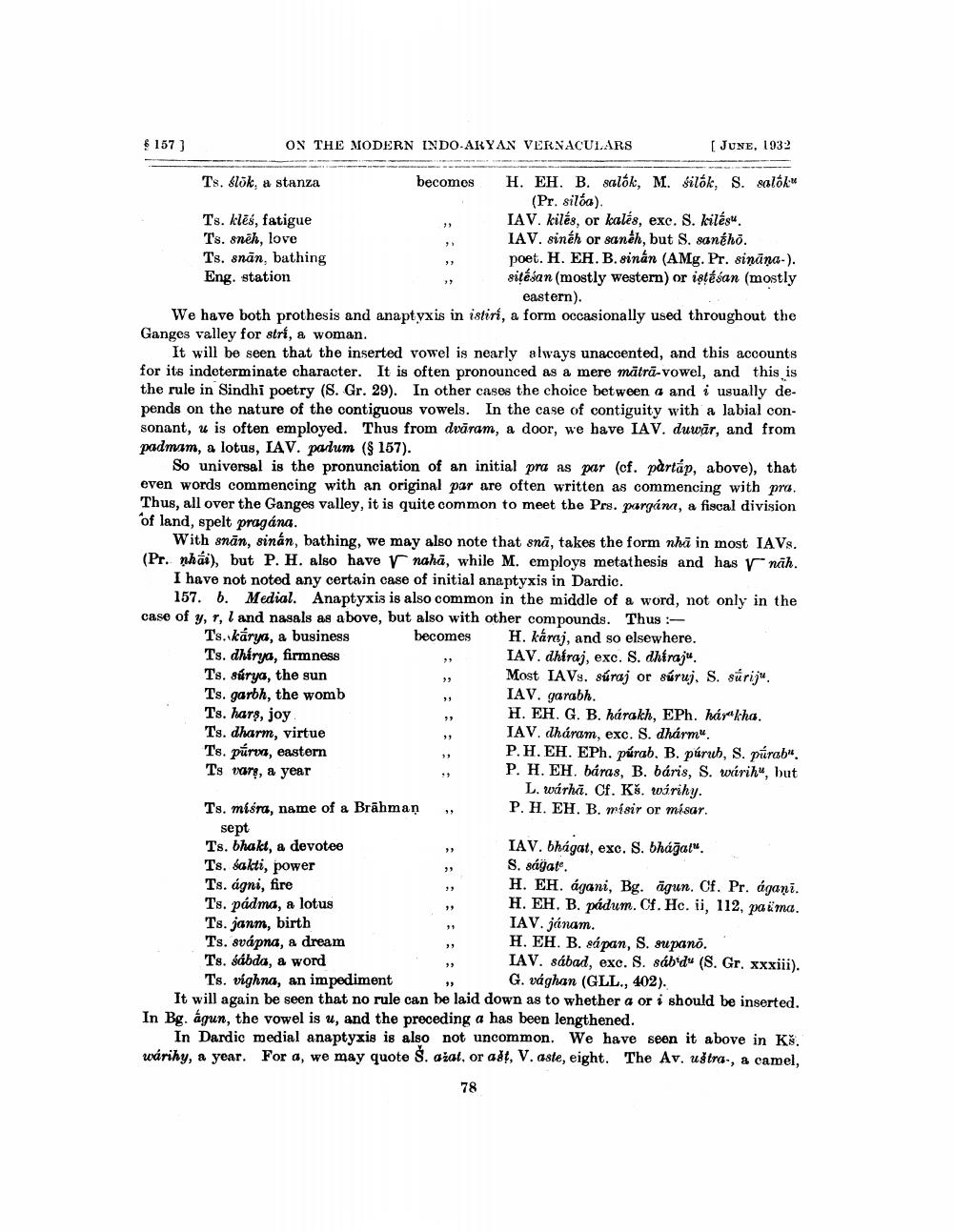________________
$ 157 )
ON THE MODERN INDO-AKYAN VERNACULARS
[JUNE, 1932
Ts. Slök, a stanza
becomes H. EH. B. salók, M. silók, S. salók:
(Pr. silóa). Ts. klēs, fatigue
IAV. kilés, or kalés, exc. S. kilégu. Ts. sneh, love
IAV. sinéh or sanéh, but S. saného. Ts. snān, bathing
poet. H. EH. B. sinan (AMg. Pr. siņāna-). Eng. station
sitésan (mostly western) or istéśan (mostly
eastern). We have both prothesis and anaptyxis in istiri, a form occasionally used throughout the Ganges valley for strí, a woman.
It will be seen that the inserted vowel is nearly always unaccented, and this accounts for its indeterminate character. It is often pronounced as a mere mätrā-vowel, and this is the rule in Sindhi poetry (S. Gr. 29). In other cases the choice between a and i usually depends on the nature of the contiguous vowels. In the case of contiguity with a labial consonant, u is often employed. Thus from dvāram, a door, we have IAV. duwār, and from padmam, a lotus, IAV. pardum ($ 157).
So universal is the pronunciation of an initial pra as par (cf. pártáp, above), that even words commencing with an original par are often written as commencing with pro. Thus, all over the Ganges valley, it is quite common to meet the Prs. pargana, a fiscal division of land, spelt pragána.
With snän, sinan, bathing, we may also note that snā, takes the form nhà in most IAVs. (Pr. nhái), but P. H. also have r nahā, while M. employs metathesis and has r näh.
I have not noted any certain case of initial anaptyxis in Dardic.
157. b. Medial. Anaptyxis is also common in the middle of a word, not only in the case of y, r, I and nasals as above, but also with other compounds. Thus
Ts. karya, a business becomes H. käraj, and so elsewhere. Ts. dhirya, firmness
IAV. dhiraj, exc. S. dhiraju. Ts. súrya, the sun
Most IAVs. súraj or súruj. S. súriju. Ts. garbh, the womb
IAV. garabh. Ts. hars, joy
H. EH. G. B. hárakh, EPh. hárkha. Ts. dharm, virtue
IAV. dháram, exc. S. dhárm". Ts. púrra, eastern
P.H. EH. EPh. púrab. B. púrub, S. piirab". Ts vars, a year
P. H. EH. báras, B. báris, S. wirih, but
L. wárha. Cf. Kš. wirihy. Ts. misra, name of a Brāhman
P. H. EH. B. misir or misar. sept Ts. bhakt, a devotee
IAV. bhagat, exc. S. bháğal". Ts. Sakti, power
S. ságatTs. ágni, fire
H. EH. ágani, Bg. agun. Cf. Pr. ágani. Ts. pádma, a lotus
H. EH, B. pádum. Cf. Hc. ii, 112, pa üma. Ts. janm, birth
IAV. jánam. Ts. svápna, a dream
H. EH. B. sápan, S. supano. Ts. sábda, a word
LAV. sábad, exc. S. sábid (S. Gr. xxxiii). Ts. vighna, an impediment , G. vághan (GLL., 402). It will again be seen that no rule can be laid down as to whether a or i should be inserted. In Bg. águn, the vowel is u, and the preceding a has been lengthened.
In Dardic medial anaptyxis is also not uncommon. We have seen it above in Kš. wárihy, a year. For a, we may quote 8. ažal, or adt, V. aste, eight. The Av, ustra, a camel,
78




